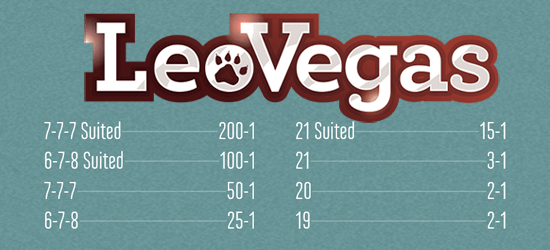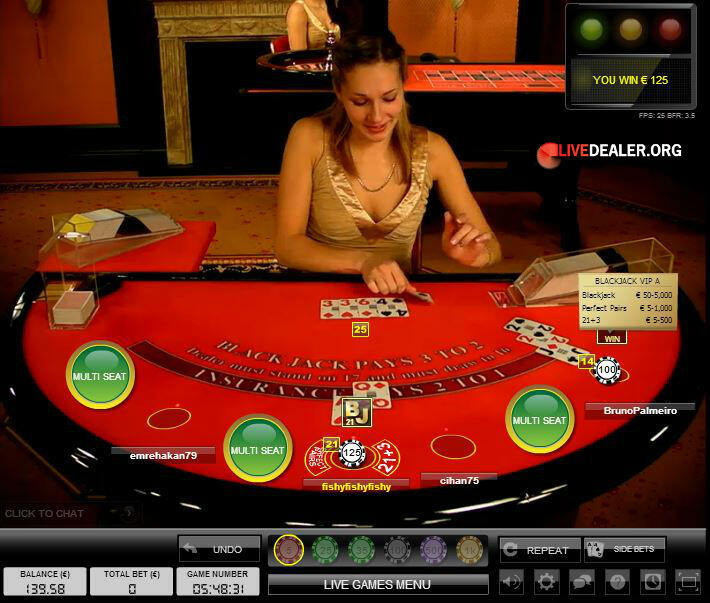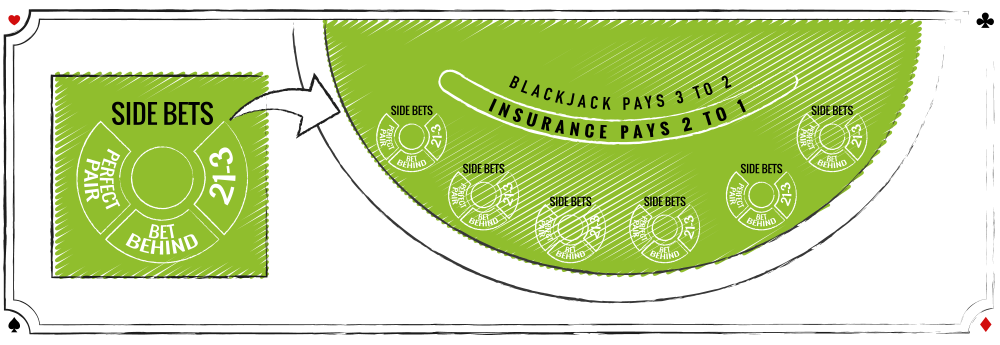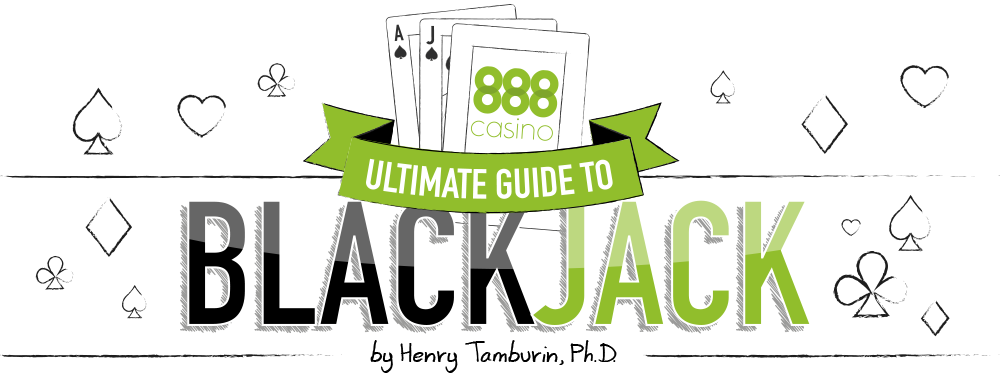On This Page

Introduction
Blackjack Side Rules. Above, the basic rules of blackjack are described. In addition, numerous side rules allow for more intricate betting strategies. These side rules can only be used immediately after the deal, before you take any more cards. You cannot, for example, take a third card and then decide to double down. The side bet pays based on the player's first two cards and the dealer's up card. If the three cards equal a flush, straight, straight flush, or three of a kind the side bet pays 9 to 1. The following table shows the probability of each hand in a six-deck game,as played at the Hilton.
- All Bets Blackjack: Essentially a combination of all the best blackjack games rolled into one, All Bets takes the classic format and adds six bonus options to the mix. Borrowing from Perfect Blackjack, Lucky Lucky and more, All Bets Blackjack is the best way to play for bonus wins in the game of 21. Blackjack Rules & Card Counting.
- Welcome to the Texas Holdem strategy section where you'll find a full range of Texas Holdem poker tips for all skill levels. Articles are split up into beginner, cash game and tournament sections, with shorthanded, full-ring, MTT, SNG and essential tips all included.
- 4-Deck to 8-Deck Blackjack Strategy Introduction. To use the basic strategy, look up your hand along the left vertical edge and the dealer's up card along the top.
To use the basic strategy, look up your hand along the left vertical edge and the dealer's up card along the top. In both cases an A stands for ace. From top to bottom are the hard totals, soft totals, and splittable hands. There are two charts depending on whether the dealer hits or stands on soft 17.
Other basic strategy rules.
- Never take insurance or 'even money.'
- If there is no row for splitting (fives and tens), then look up your hand as a hard total (10 or 20).
- If you can't split because of a limit on re-splitting, then look up your hand as a hard total, except aces. In the extremely unlikely event you have a pair of aces you can't re-split and drawing to split aces is allowed, then double against a 6, otherwise hit.
If you play a mixture of six-deck games, some where the dealer hits a soft 17, and some where he stands, and you only wish to memorize one strategy, I would recommend you memorize the one where the dealer stands on soft 17. The cost in errors due to playing the wrong strategy is 2.3 times higher playing a stand on soft 17 game, with the hit on 17 strategy, than vise versa.

Basic Strategy in Text
For the benefit of my blind readers, here is the above strategy in text form, when the dealer stands on soft 17 and surrender is allowed. To use the strategy, start at the top, and follow the first rule that applies.
Surrender
- Surrender hard 16 (but not a pair of 8s) vs. dealer 9, 10, or A, and hard 15 vs. dealer 10.
Split
- Always split aces and 8s.
- Never split 5s and 10s.
- Split 2s and 3s against a dealer 4-7, and against a 2 or 3 if DAS is allowed.
- Split 4s only if DAS is allowed and the dealer shows a 5 or 6.
- Split 6s against a dealer 3-6, and against a 2 if DAS is allowed.
- Split 7s against a dealer 2-7.
- Split 9s against a dealer 2-6 or 8-9.
Double
- Double hard 9 vs. dealer 3-6.
- Double hard 10 except against a dealer 10 or A.
- Double hard 11 except against a dealer A.
- Double soft 13 or 14 vs. dealer 5-6.
- Double soft 15 or 16 vs. dealer 4-6.
- Double soft 17 or 18 vs. dealer 3-6.

Hit or Stand
- Always hit hard 11 or less.
- Stand on hard 12 against a dealer 4-6, otherwise hit.
- Stand on hard 13-16 against a dealer 2-6, otherwise hit.
- Always stand on hard 17 or more.
- Always hit soft 17 or less.
- Stand on soft 18 except hit against a dealer 9, 10, or A.
- Always stand on soft 19 or more.
As I've said many times, the above strategy will be fine under any set of rules. However, for you perfectionists out there, here are the modifications to make if the dealer hits a soft 17.
- Surrender 15, a pair of 8s, and 17 vs. dealer A.
- Double 11 vs. dealer A.
- Double soft 18 vs. dealer 2.
- Double soft 19 vs. dealer 6.
My thanks to Kelly for putting together the above text strategy.

Written by:Michael Shackleford
- Appendices
- Miscellaneous
- External Links
Version 1
Version 1 of 21+3 I noticed at the Las Vegas Hilton in April, 2001. The side bet pays based on the player's first two cards and the dealer's up card. If the three cards equal a flush, straight, straight flush, or three of a kind the side bet pays 9 to 1. The following table shows the probability of each hand in a six-deck game,as played at the Hilton.
21+3 — 6 decks
| Hand | Combinations | Probability | Pays | Return |
|---|---|---|---|---|
| Straight flush | 10368 | 0.002068 | 9 to 1 | 0.018613 |
| Three of a kind | 26312 | 0.005248 | 9 to 1 | 0.047236 |
| Straight | 155520 | 0.031021 | 9 to 1 | 0.279192 |
| Flush | 236736 | 0.047221 | 9 to 1 | 0.424993 |
| Pair+flush | 56160 | 0.011202 | 9 to 1 | 0.100819 |
| Pair (no flush) | 977184 | 0.194918 | Loss | -0.194918 |
| Nothing | 3551040 | 0.708321 | Loss | -0.708321 |
| Total | 5013320 | 1 | -0.032386 |
Following is the house edge for 4, 6, and 8 decks.
- 4 decks — 4.24%
- 6 decks — 3.24%
- 8 decks — 2.74%
Version 2
At the Regent (now known as the Rampart) in Las Vegas all hands listed above, plus a pair, pay 5 to 2. I'll call this version 2. Two decks are used in this version. The following table shows a house edge under these rules of 2.78%.
21+3 — 2 decks
| Hand | Combinations | Probability | Pays | Return |
|---|---|---|---|---|
| Straight flush | 384 | 0.002109 | 2.5 to 1 | 0.005272 |
| Three of a kind | 728 | 0.003998 | 2.5 to 1 | 0.009994 |
| Straight | 5760 | 0.03163 | 2.5 to 1 | 0.079076 |
| Flush | 8768 | 0.048148 | 2.5 to 1 | 0.120371 |
| Pair | 34944 | 0.19189 | 2.5 to 1 | 0.479726 |
| Nothing | 131520 | 0.722225 | Loss | -0.722225 |
| Total | 182104 | 1 | -0.027786 |
Version 3
I have an unconfirmed report that Internet casinos using Wagerworks software use the following pay table, which I will call 'Version 3.'
21+3 — Version 3 — Six Decks
| Hand | Pays | Combinations | Probability | Return |
|---|---|---|---|---|
| Suited three of a kind | 100 | 1040 | 0.000207 | 0.020745 |
| Three of a kind | 33 | 25272 | 0.005041 | 0.166352 |
| Straight flush | 35 | 10368 | 0.002068 | 0.072383 |
| Straight | 10 | 155520 | 0.031021 | 0.310214 |
| Flush | 5 | 292896 | 0.058424 | 0.292118 |
| Loss | -1 | 4528224 | 0.903239 | -0.903239 |
| Total | 5013320 | 1 | -0.041427 |
Although Wager Works only uses six decks in their blackjack game, as far as I know, here is the house edge for 3 to 8 decks.
21+3 — Version 3 — 3-8 Decks
| Decks | House Edge |
|---|---|
| 3 | 7.76% |
| 4 | 5.99% |
| 5 | 4.89% |
| 6 | 4.14% |
| 7 | 3.60% |
| 8 | 3.18% |
Version 4
This version, with a 30-20-10-5 pay table, is known as '21+3 Xtreme.' The following return table shows the house edge for six decks is 13.39% (ouch!).
21+3 — Version 4 — Six Decks
| Hand | Pays | Combinations | Probability | Return |
|---|---|---|---|---|
| Straight flush | 30 | 10,368 | 0.002068 | 0.062043 |
| Three of a kind | 20 | 26,312 | 0.005248 | 0.104968 |
| Straight | 10 | 155,520 | 0.031021 | 0.310214 |
| Flush | 5 | 292,896 | 0.058424 | 0.292118 |
| Loser | -1 | 4,528,224 | 0.903239 | -0.903239 |
| Total | 5,013,320 | 1.000000 | -0.133896 |
If you happen to see it with other than six decks, here is the expected value for various number of decks.
21+3 — Version 4 -- 1 to 8 Deck Summary
| Decks | Expected Value |
|---|---|
| 1 | -0.227330 |
| 2 | -0.172736 |
| 4 | -0.143780 |
| 5 | -0.137863 |
| 6 | -0.133896 |
| 8 | -0.128912 |
The Caesars Entertainment Blog mentions that the xtreme version of 21+3 can be found in the Party Pit at the Paris casino in Las Vegas. I had to chuckle at their sense of humor with this remark,
'We would calculate the odds of hitting these side bets, but being in Vegas isn't about math, it's about having fun. And just never-you-mind that this is the blog of a casino company. Check out the new Ooh La La Party Pit at Paris Las Vegas the next time you’re in the neighborhood.
Hey, it is about the math everywhere, even in the Party Pit!
Version 5
I saw this version at an Internet casino using live dealers from Evolution Gaming. Following is the return table, based on eight decks.
21+3 — Version 5 — 8 Decks
| Event | Pays | Combinations | Probability | Return |
|---|---|---|---|---|
| Suited three of a kind | 100 | 2,912 | 0.000244 | 0.024446 |
| Straight flush | 40 | 24,576 | 0.002063 | 0.082524 |
| Three of a kind | 25 | 61,568 | 0.005169 | 0.129213 |
| Straight | 10 | 368,640 | 0.030947 | 0.309465 |
| Flush | 5 | 700,928 | 0.058841 | 0.294207 |
| Loser | -1 | 10,753,536 | 0.902736 | -0.902736 |
| Total | 11,912,160 | 1.000000 | -0.062882 |
Following is the house edge for this pay table for various numbers of decks.
- 4 decks: 8.78%
- 5 decks: 7.81%
- 6 decks: 7.14%
- 7 decks: 6.29%
Version 6
I have an unconfirmed report that the Ameristar in Kansas City is using the following pay table with two decks.
21+3 — Version 6 — 2 Decks
| Event | Pays | Combinations | Probability | Return |
|---|---|---|---|---|
| Straight flush | 7 | 384 | 0.002109 | 0.014761 |
| Three of a kind | 7 | 728 | 0.003998 | 0.027984 |
| Straight | 7 | 5,760 | 0.031630 | 0.221412 |
| Flush | 7 | 10,016 | 0.055002 | 0.385011 |
| Pair | 0 | 33,696 | 0.185037 | 0.000000 |
| Loser | -1 | 131,520 | 0.722225 | -0.722225 |
| Total | 182,104 | 1.000000 | -0.073057 |
Are Side Bets In Blackjack Worth It
The next table shows the house edge of the Version 6 pay table by number of decks.
Side Bets Blackjack Rules Card Game
21+3 — Version 6
Version 7
This pay table I hear is used by live dealer casinos by Evolution Gaming, which use eight decks.
21+3 — Version 7 — 8 Decks
| Event | Pays | Combinations | Probability | Return |
|---|---|---|---|---|
| Suited three of a kind | 100 | 2,912 | 0.000244 | 0.024446 |
| Straight flush | 40 | 24,576 | 0.002063 | 0.082524 |
| Three of a kind | 30 | 61,568 | 0.005169 | 0.155055 |
| Straight | 10 | 368,640 | 0.030947 | 0.309465 |
| Flush | 5 | 700,928 | 0.058841 | 0.294207 |
| Loser | -1 | 10,753,536 | 0.902736 | -0.902736 |
| Total | 11,912,160 | 1.000000 | -0.037039 |
Here is the house edge for four and six decks.
- Four decks: 6.39%
- Six decks: 3.70%
Version 8
I think I saw this version at the Global Gaming Expo, but I'm not sure. This version is noteworthy because it pays a progressive jackpot for three suited aces. Here is the full pay table. Pays are on a 'to one' basis.
Version 8 Pay Table

| Event | Pays |
|---|---|
| Suited three aces | Jackpot |
| Suited three of a kind | 125 |
| Straight flush | 25 |
| Three of a kind | 20 |
| Straight | 7 |
| Flush | 3 |
The following table shows my analysis based on a six-deck game.
Version 8 Return Table — Six Decks
| Event | Pays | Combinations | Probability | Return |
|---|---|---|---|---|
| Suited three aces | ? | 80 | 0.000016 | ? |
| Suited three of a kind | 125 | 960 | 0.000191 | 0.023936 |
| Straight flush | 25 | 10,368 | 0.002068 | 0.051702 |
| Three of a kind | 20 | 25,272 | 0.005041 | 0.100819 |
| Straight | 7 | 155,520 | 0.031021 | 0.217150 |
| Flush | 3 | 292,896 | 0.058424 | 0.175271 |
| Loser | -1 | 4,528,224 | 0.903239 | -0.903239 |
| Total | 5,013,320 | 1.000000 | -0.334360 |
The lower right cell shows that a house edge of 33.44%, before considering the value of the jackpot. If the minimum bet is $1, then each $1,000 in the meter decreases the house edge by 1.60%. If the minimum bet is $5, then each $10,000 in the meter decreases the house edge by 3.19%.
The breakeven points, where the house edge is zero, is $27,016.90 for a $1 bet and $135,084.50 for a $5 bet, based on six decks.
Version 9
I saw this version at the Rampart casino in Las Vegas on January 29, 2021 . This version is similar to version 8, except a suited three of a kind in queens to aces is required to hit the jackpot and it is a $1 'red light' bet, meaning pays are on a 'for one' basis. Following is the pay table.
Version 9 Pay Table
| Event | Pays |
|---|---|
| Suited three of a kind (Q's-A's) | Jackpot |
| Suited three of a kind (2's-J's) | $125 |
| Straight flush | $25 |
| Three of a kind | $20 |
| Straight | $6 |
| Flush | $2 |
The following table shows my analysis based on a six-deck game.
Version 9 Return Table — Six Decks
| Event | Pays | Combinations | Probability | Return |
|---|---|---|---|---|
| Suited three of a kind (Q's-A's) | Jackpot | 240 | 0.000048 | ? |
| Suited three of a kind (2's-J's) | $125.00 | 800 | 0.000160 | 0.019947 |
| Straight flush | $25.00 | 10,368 | 0.002068 | 0.051702 |
| Three of a kind | $20.00 | 25,272 | 0.005041 | 0.100819 |
| Straight | $6.00 | 155,520 | 0.031021 | 0.186128 |
| Flush | $2.00 | 292,896 | 0.058424 | 0.116847 |
| Loser | $- | 4,528,224 | 0.903239 | 0.000000 |
| Total | 5,013,320 | 1.000000 | 0.475444 + ? |
The lower right cell an expected return of 47.54%, before considering the value of the jackpot. Each $1,000 in the jackpot increases the return by 4.79%. For example, at the time I saw this side bet the jackpot was at $3,886.15, for an expected return of 66.15%.
The breakeven point, with no house edge, is at a jackpot of $10,957.37.
Written by: Michael Shackleford